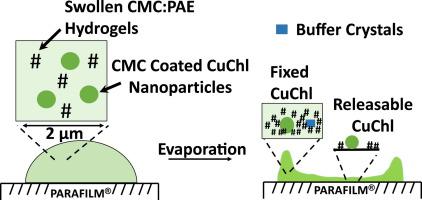Journal of Colloid and Interface Science ( IF 9.4 ) Pub Date : 2020-09-08 , DOI: 10.1016/j.jcis.2020.09.014 Fengyan Wang 1 , Wenzi Ckurshumova 2 , Jun Liu 2 , Michael Fefer 2 , Robert H Pelton 1

|
The chlorophyll derivative copper chlorophyllin and related chlorins have promise as environmentally friendly agricultural chemicals, however, spray application is hindered by the propensity of dried spray deposits to wash off leaf surfaces during rain or irrigation.
Hypothesis
Polyelectrolyte complexes formed between anionic carboxymethyl cellulose and cationic polyamidoamine-epichlorohydrin can prevent the release of copper chlorophyllin from dried spray deposits on leaf surfaces when exposed to water.
Experiments
Sessile drops on parafilm and containing polyelectrolyte complex and copper chlorophyllin or Brilliant Sulfaflavine, an anionic water-soluble dye, were dried to form deposits that were physical models for crop spray drop deposits on hydrophobic leaf surfaces. Larger buffer drops were placed on the dried deposits and the release of copper chlorophyllin or the dye were measured.
Findings
Copper chlorophyllin showed some immediate (burst) release upon exposure to buffer whereas the remainder was immobilized on the parafilm. By contrast, Brilliant Sulfaflavine displayed rapid release following square root time dependence, typical of a diffusion-controlled process. The unusual behavior of copper chlorophyllin is attributed to the presence of CuChl nanoparticles when dispersed in water. The nanoparticles are encased in the polyelectrolyte complex that adheres to parafilm. The fraction of the added copper chlorophyllin lost in the burst release can be controlled by varying the polyelectrolyte complex composition and concentration.
中文翻译:

防止叶绿素铜从农作物喷雾沉积物的疏水表面释放。
叶绿素衍生物叶绿素铜和相关的二氢卟酚有望作为环保型农业化学品使用,但是由于干燥的喷雾沉积物在雨天或灌溉期间倾向于洗去叶片表面而阻碍了喷雾应用。
假设
阴离子羧甲基纤维素和阳离子聚酰胺酰胺-表氯醇之间形成的聚电解质络合物可以防止暴露于水时叶表面干燥喷雾沉积物释放出叶绿素铜。
实验
将干膜上的无滴液滴干燥,使其形成聚电解质络合物和叶绿素铜或阴离子水溶性染料亮绿磺胺黄酮,形成沉淀物,该沉淀物是疏水叶表面上作物喷雾液滴沉积物的物理模型。将较大的缓冲液滴放在干燥的沉淀上,并测量叶绿素铜或染料的释放。
发现
叶绿素铜暴露在缓冲液中后会立即释放(爆发),而其余的则固定在副膜上。相反,辉煌的磺胺黄素在平方根时间依赖性之后表现出快速释放,这是扩散控制过程的典型特征。叶绿素铜的异常行为归因于分散在水中的CuChl纳米粒子的存在。纳米颗粒被包裹在粘附在石蜡膜上的聚电解质复合物中。可通过改变聚电解质复合物的组成和浓度来控制在突发释放中损失的添加的叶绿素铜铜的分数。











































 京公网安备 11010802027423号
京公网安备 11010802027423号